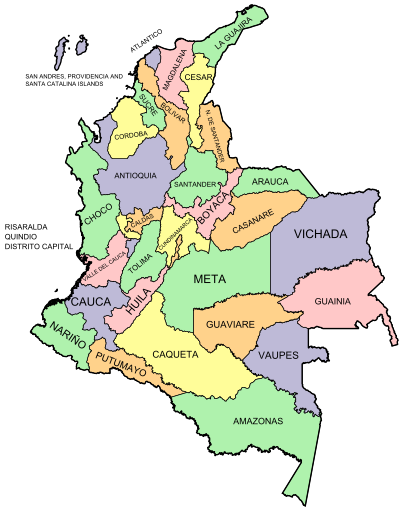Departments of Colombia
| Capital district and departments of Colombia Distrito Capital y los Departamentos de Colombia (Spanish) |
|
|---|---|
| Category | Unitary state |
| Location | Republic of Colombia |
| Number | 32 Departments 1 Capital District |
| Populations | (Departments only):33,152 (Vaupés) – 5,750,478 (Antioquia) |
| Areas | (Departments only):50 km2 (19.3 sq mi) (San Andrés) – 109,665.0 km2 (42,341.89 sq mi) (Amazonas) |
| Government | Department government, National government |
| Subdivisions | Municipality |
Colombia is a unitary republic formed by thirty-two departments (Spanish: departamentos, sing. departamento) and a Capital District (Distrito Capital). Each department has a Governor (gobernador) and a Department Assembly (Asamblea Departamental), elected by popular vote for a four-year period. The governor cannot be re-elected in consecutive periods. Departments are country subdivisions and are granted a certain degree of autonomy.
Departments are formed by a grouping of municipalities (municipios, sing. municipio). Municipal government is headed by mayor (alcalde) and administered by a Municipal Council (concejo municipal), both of which are elected for four-year periods.
Each one of the departments of Colombia in the map below links to a corresponding article.
The indigenous territories are at the third level of administrative division in Colombia, as are the municipalities. Indigenous territories are created by agreement between the government and indigenous communities. In cases where indigenous territories covering more than one department or municipality, local governments jointly administer them with the indigenous councils, as set out in Articles 329 and 330 of the Colombian Constitution of 1991. Also indigenous territories may achieve local autonomy if they meet the requirements of the law.
Article 329 of the 1991 constitution recognizes the collective indigenous ownership of indigenous territories and repeats that are inalienable. Law 160 of 1994 created the National System of Agrarian Reform and Rural Development Campesino, and replaced Law 135 of 1961 on Agrarian Social Reform; it establishes and sets out the functions of INCORA, one of the most important being to declare which territories will acquire the status of indigenous protection and what extension of existing ones will be allowed. Decree 2164 of 1995 interprets Law 160 of 1994, providing, among other things, a legal definition of indigenous territories.
...
Wikipedia


